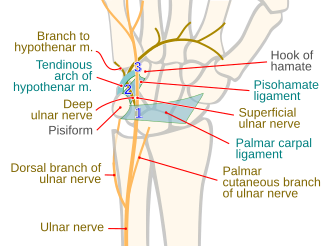Ulnar nerve
A major nerve of the upper limb

The ulnar nerve is one of the major nerves of the upper limb. It is part of the brachial plexus and is responsible for innervating several muscles in the forearm and hand, as well as providing sensation to the skin of the hand.
Anatomy[edit]
The ulnar nerve originates from the brachial plexus, specifically from the medial cord, which contains fibers from the C8 and T1 nerve roots. It travels down the arm, passing posterior to the medial epicondyle of the humerus, where it is superficial and can be palpated. This location is commonly referred to as the "funny bone" because striking the nerve here can cause a tingling sensation.

In the forearm, the ulnar nerve travels between the flexor carpi ulnaris and the flexor digitorum profundus muscles. It provides motor innervation to the flexor carpi ulnaris and the medial half of the flexor digitorum profundus. The nerve then enters the hand through Guyon's canal, a fibro-osseous tunnel at the wrist.
Function[edit]
The ulnar nerve is responsible for both motor and sensory functions. In the hand, it innervates the hypothenar muscles, the adductor pollicis, the interossei muscles, and the medial two lumbricals. These muscles are crucial for fine motor control and grip strength.

Sensory innervation by the ulnar nerve includes the skin of the medial one and a half fingers (the little finger and half of the ring finger) and the associated palm area.
Clinical significance[edit]
The ulnar nerve is susceptible to injury at several points along its course. Common sites of injury include the elbow, where it can be compressed in the cubital tunnel, and the wrist, where it can be compressed in Guyon's canal.

Cubital Tunnel Syndrome[edit]
Cubital tunnel syndrome occurs when the ulnar nerve is compressed at the elbow. Symptoms include numbness and tingling in the ring and little fingers, weakness in the hand, and pain in the elbow.
Guyon's Canal Syndrome[edit]
Guyon's canal syndrome, also known as ulnar tunnel syndrome, results from compression of the ulnar nerve at the wrist. It can cause similar symptoms to cubital tunnel syndrome, but the location of the compression is different.
Related pages[edit]

See also[edit]
Ad. Transform your life with W8MD's Budget GLP-1 injections from $75


W8MD offers a medical weight loss program to lose weight in Philadelphia. Our physician-supervised medical weight loss provides:
- Weight loss injections in NYC (generic and brand names):
- Zepbound / Mounjaro, Wegovy / Ozempic, Saxenda
- Most insurances accepted or discounted self-pay rates. We will obtain insurance prior authorizations if needed.
- Generic GLP1 weight loss injections from $75 for the starting dose.
- Also offer prescription weight loss medications including Phentermine, Qsymia, Diethylpropion, Contrave etc.
NYC weight loss doctor appointmentsNYC weight loss doctor appointments
Start your NYC weight loss journey today at our NYC medical weight loss and Philadelphia medical weight loss clinics.
- Call 718-946-5500 to lose weight in NYC or for medical weight loss in Philadelphia 215-676-2334.
- Tags:NYC medical weight loss, Philadelphia lose weight Zepbound NYC, Budget GLP1 weight loss injections, Wegovy Philadelphia, Wegovy NYC, Philadelphia medical weight loss, Brookly weight loss and Wegovy NYC
|
WikiMD's Wellness Encyclopedia |
| Let Food Be Thy Medicine Medicine Thy Food - Hippocrates |
Medical Disclaimer: WikiMD is not a substitute for professional medical advice. The information on WikiMD is provided as an information resource only, may be incorrect, outdated or misleading, and is not to be used or relied on for any diagnostic or treatment purposes. Please consult your health care provider before making any healthcare decisions or for guidance about a specific medical condition. WikiMD expressly disclaims responsibility, and shall have no liability, for any damages, loss, injury, or liability whatsoever suffered as a result of your reliance on the information contained in this site. By visiting this site you agree to the foregoing terms and conditions, which may from time to time be changed or supplemented by WikiMD. If you do not agree to the foregoing terms and conditions, you should not enter or use this site. See full disclaimer.
Credits:Most images are courtesy of Wikimedia commons, and templates, categories Wikipedia, licensed under CC BY SA or similar.
Translate this page: - East Asian
中文,
日本,
한국어,
South Asian
हिन्दी,
தமிழ்,
తెలుగు,
Urdu,
ಕನ್ನಡ,
Southeast Asian
Indonesian,
Vietnamese,
Thai,
မြန်မာဘာသာ,
বাংলা
European
español,
Deutsch,
français,
Greek,
português do Brasil,
polski,
română,
русский,
Nederlands,
norsk,
svenska,
suomi,
Italian
Middle Eastern & African
عربى,
Turkish,
Persian,
Hebrew,
Afrikaans,
isiZulu,
Kiswahili,
Other
Bulgarian,
Hungarian,
Czech,
Swedish,
മലയാളം,
मराठी,
ਪੰਜਾਬੀ,
ગુજરાતી,
Portuguese,
Ukrainian